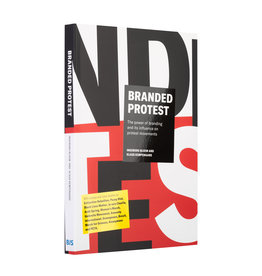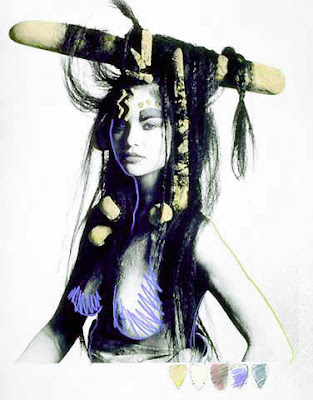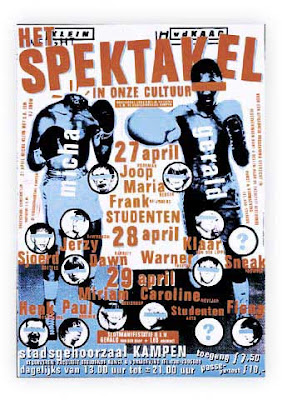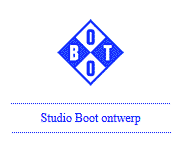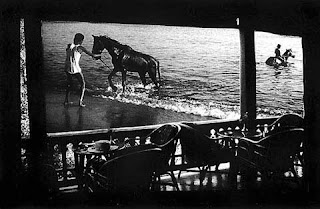“Photo-designers’ have no future!”,
a critical speech by Urs Schwerzmann, art-director, held at a professional symposium in
1992 in Frankfurt, Germany.
"Images start in your head; image-makers have to define new image contents."
Several announcements on the radio, television and in the papers during the last 3 weeks. A notice about Mannheim clinic in the evening program of local television. They introduced a new x-ray camera installed with funding from the EEC. Instead of the old method, patients are now scanned digitally, so they are less exposed to radiation. The images are immediately available, only the ones that are used are being filed. Benefit for the clinic: faster, better and more economic.
Newspaper and Science
Production (in baroque-style) with Sony has led to a shorter life of the production. Usually Sony needs 6 months for developing the products, production takes 3 months and it is sold for only a few months.
ARD entertainment evening program.
In “Showvenster” schlager composer Michael Cretou told how he makes his world-wide hits in his studio on Ibiza. In his home studio he mixes all ingredients from his archive. He makes new compositions, leaves something out, adds some string-music or voices and a new hit is born. Without any help of life musicians. Copies from the archives and (mixing-tables) replace musicians and the recording studio.
New values
After the spectacular fall of the DDR and of the entire communistic regime and the have and have not in today’s society, search for a new ideology becomes a matter of survival. Although we are always short of time now, time will be largely at hand in the future. We will not only work to earn money but also to fill time. Work, as we know it today, will become something precious. Because of rationalisations in electronics, labour, as we know it today, will gradually be taken over by machines. Work instead of 'must do something' will become 'can do something'.
Where do the images come from?
Are these events without meaning for photographers? Or are they perhaps indications to an era of changing communications? Like e.g. the production of images.
What will happen or has happened already? Up till now a image was produced ‘live’, the future will be all about filing images. The prospects are already known:
1. the archives are more than full, everything has already been photographed
2. technology, equipment and operators are available
3. environment and economics will force us to do so.
To photograph images and sets ‘life’ will no longer be economic because of these facts:
1. shorter life cycle of the products.
2. the expenses are higher than the earnings
3. technology is available to do it another way.
New products are designed on computers, new worlds can easily be simulated and experienced on a monitor.
Example: kitchens will no longer be photographed but simulated 3-dimensionally on the computer. The client enters his new kitchen, tests work situations, tests his work environment, choose colours worktable surface and everything else. After he has chosen for his new kitchen, which he has just experienced, almost for real, the computer orders everything including (building)plans. And that is that!
Cyberspace on the point of sale, today possible, common tomorrow. This means that constructors, consumers and the production are developing a new product all at the same time! Decisions like surroundings, images and motives are simulated in the computer. Advertising as we know it today, will no longer be necessary in the future.
Press photography for example, a report on the Europa cup finals is shot with electronic camera’s. Individual camera’s are permanently pointed at each of the 22 players. The digital images are being filtered by a computer program that directs, and at the same time sent to the media.
There the images are being selected, manufactured in the “real time”.
Who is paying?
Imagine the following: A postorder firm has its summer catalogue photographed in Miami. At the same time television commercials and adverts are produced for all sorts of media. A production of more than a million starts. Absolute madness and a very high risk.
The following scenario could present itself in the future; products could be designed in a artificial way (on a screen). All images used for adverbs are also filed in a low resolution. Assuming that a catalogue would be made in the normal way which means environmental and too expensive paper then the products will only be manufactured the moment the customer orders them.
‘Just in time’ is an understanding in electronics, when used for development, logistics and preparation, slowly but certainly becomes reality. ‘Just in time’ or ‘time compressing’, or whatever you call it, the purpose is the same: development, production, commerce, consuming, to lower the costs and increase the profit. Where do photographers stand in this game?
Pressure increases, The client is under pressure, so the photographer is under pressure. But why?
Production sites are far too expensive. Production cycle gets shorter. Development get faster. Pressure changes the relations. Also the relation towards the client, will change communications.
First just as an instrument of the internal and business communications, but that gives the client all means to restructure and organise their way of communication.
For those who are dependent on the production it is good to know that besides the making, also the marketing and advertising will change.
The real advantages for the producers are: a better environment, quality of life and labour market. Enterprises will have a better understanding of national income than a lot of us do nowadays. Otherwise said; the future is more complex than we think. Money will keep its value but that is only one thing. First the EEC acts as a stage, shortly after that comes Eastern Europe, Africa, South America and later on the whole world.
Pressure on the client will be passed on to the suppliers whether they are creative or not.
Position/Stand
This will be relevant in two ways: on one side the physically feasible, the geographical homeland, on the other side the psychologically opponent, the spiritual homeland.
First the geographical stand: this will be a debacle. The EEC, and the opening of the borders (1993) haven’t made things easier. The professional freelance photographer is degraded to a photoshop from around the corner. There is no need of being present any longer, nobody will pay for your travel-expenses although distances will be greater. Nobody will expect you to be present at a briefing, but one should be attainable at all times. These are just two of the many changes that can be solved immediately with the available technique. But the will to invest stops with a lot of people with buying a new fax machine.
The psychologically apparent: Illusionary world, make belief, lies
Every image made on commission for a client, only shows an illusionary world, but exists for real in the imagination of the creator and the client. Dreams are being created. Even at this very moment. Non-existing spaces, feelings etc. nowadays are put together in an image, using sophisticated casting, fascinating lighting and perfect styling are being put together in an image or a photo..
This is completely over.This is one of the reasons why I believe that an illusionary world can be created without help, much cheaper, faster, more efficient, colourful and more perfect. The only difference between today and tomorrow will be that we don’t need a real existing world any longer, but create images made up nowadays with lots of time and money.
Everything needs to be possible. Images are not only made by photographers, together they are the result of : CD’s, art-directors, copywriters, public-relations, marketing, product developments etc.
The guest for photographers as such and his knowledge is no longer in demand.
There is no more reason to commission a photograph in that way. His creativity his other disciplines have been necessary up till now. His experience in location styling and lighting is electronically established for everybody and everywhere available. In the future we have images of all archives per modem at hand. All information of all available images, including light, space, models, accessories, movements, expression etc. Helmut Newton) are recorded in a special program. When creators decide to use the photo style of Newton for a photo of a product X, they will make use of the program “Newton, Helmut”. And the models, lighting and location are put together on the screen in Newton style with the product that is to be promoted. That’s the way Claudia Schiffer, together with Doris Day becomes the ideal model for product XY. All this without copyright in spite of living inheritors, or whether they died in 1832.
Enemies, friends pen pals
The relation between art-directors and photographers (now still friendly because they need and respect each other) becomes a rivalry of competition because of the changes in producing images. The art-director is going to create his own images. So do all the others. Unbelievable? Simply ask your (still) friends, the art-directors. Ask the art-director of Macdonald “How many pictures had you made in 1991”?
“Two, each time a dish, cut out of the background”.
Or how do you explain the attitude of former friends, the laboratories, dependent for years on you and your goodwill ? They invest millions in desktop publishing. Investments they can’t regain from their traditional clients, the photographers. So they try to find new clients, etc. advertising agencies. The laboratories invite them to make their images directly on the computer. An operator earns approx. 250 DM an hour. (or 2.000 DM a day). Of course, printers and service-bureaux offer the same services. And the more there are, the cheaper they will be. In the example of the “new” laboratories ,the new electronic image world becomes the most clear: for art directors a possibility to compose images in a fast and economic way and for photographers a possibility to retouch photographs fast and easy.
The curse of the techniques
The computer (workstation) is just a box, stupid and without any talent. The computer is not a threat for photography, it is just a tool which can be used to optimise images quicker and cheaper. It is not for more creativity, but for a more economic use in a technically orientated world.
The real change is when no photographic skills are asked from the operator and his client. At least no craftsmanship or professional qualification.
Is the photographer a victim of fast development or did he just not pay attention or has forgotten that except earning money. also other values count? Shouldn’t he have changed over earlier to techniques? Or has he been completely forgotten by his partners: camera factories, big film companies and laboratories? No! The end of the photographic profession has been present from the beginning. The image of his world is historically determinant. He admires art photography and he believes that he himself is a part of an art movement and furthermore for 90 percent he is just an operator. An operator of a machine which, like all machines has been made abundant because of the introduction of electronics. He hasn’t fully understood that making images is not a cultural relevant process in itself but a mechanical process. Machines have been programmed and photographers have even forgotten to write the programs. They forgot to interfere with progress.
Take for instance the professional organisations they only occupy themselves with questions about copyrights. That is why they were founded (in a time that problems were already to be foreseen).
Problems that became even worse because of the electronic image storage and manipulation. They do not does not engage with photography its content and future, but just with photographers and their status. A phenomenon they share with all well known unions with status. They will try to protect photographs and copyright, what’s the use of that. Every image archive offers more and better images, every scanner can copy all these images and every program that does not cost more than 2000 DM can make a new image. The downfall of image archives is near, they all invest hecticly in electronic image transfer and archiving.
Are you really just starting to protect your status as a designer, while every other creative person can take over your profession? Try to make better images with a computer, while every computer can make a better image faster and cheaper? Do you think you are the only one who can deliver quality? Forgetting that quality is a changing factor. It could be that no one is asking for quality any more. You can only engage in a discussion about quality when you feel that quality and status are the only goals of the future.
The photographers will appeal to their historically gained right of existence and hardly try to rewrite the philosophy of photography and define a new content, or are they?
What remains is hope, posterity, youth
I don't believe that. Because what I am hoping for, and with that I mean posterity, and experience is historical hocus-pocus. On the one side the art-schools, led by professors and governed from the past. Amazed one is rubbing his eyes, seeing which novelties are demonstrated by youngsters. Style and way of expression, it is immediately clear where it originates. The historical phrases, fashionable trends, the result of the German art-schools, whether a school or a studio. Not a trace of laboratories or research-institutes. On the other hand the skilful youth, fascinated by computers. If the copier was the unifying factor in the portfolios of all the German photographers, now the computer is the guillotine of creativity of this same skilful youth. Instead of being creative themselves, they leave this to the computer. Furthermore they should have foreseen this disastrous development in related professions as designers and architects. In stead of improved technique (new machines make everything far more easy) and a new philosophy ( new enterprises need new goals) we get a pitiful image stuttering; not fit to be seen, not to be printed; lots of noise and no real gain. That or something similar, said our parents about us. So, at least hope remains that they, who will make the images of tomorrow, will unmask my considerations as hair-splitting or the know-it -all of an art-director. Stemming from the inability not being able to photograph like them.
New goals
Who will make photographs in the future, like no one else can? Photography will relocate to muse, it becomes art. With this you should take into consideration that art will be more related to spare-time than with the way we look at art now. Defined in two direction:
1. the historical photography, made by you with motives and by machines as we know them.
2. experimental photography, made by new machines and with new contents
3. my personal expectations: new photography made from a mixture of this all, without regards of machines and subjects leading to a new definition of image making. The creative image-maker of the future. Not just photographers but certainly conceptual thinking 'image-makers. Maybe a few photographers will be included.
And finally
How will it proceed? What needs to be done? This calls for a quote by Ray d 'Emoulin, the personification of Mr. Kodak from Rochester, about Kodak's new project, the Center for Creative Imaging in Maine:" I have to ease the way to our industrial goal, because, when the time arrives for something new, the new is already there. I have to foresee the future. The last thing which we can use now is to say: " I wish we had adapted to electronics at the right moment.
urs@schwerzmann.de















